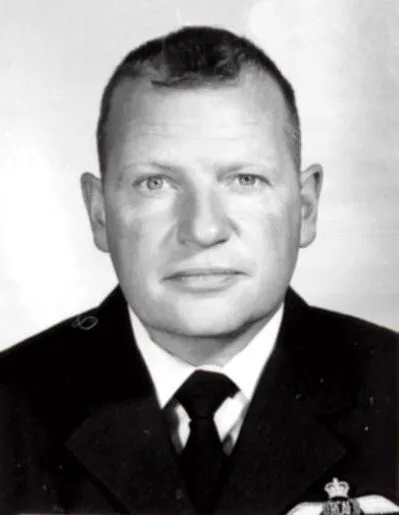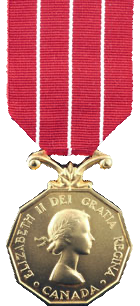Challoner, Robert Russel (Captain)
Killed in Flying Accident 1977-June-07
Service
RCAF
Unit
419 (F) Sqn- Squadron
Moosa Aswayita Beware of Moose
Base
Rank
Captain
Position
Pilot
Service Numbers
Freedom Fighter serial: 116755
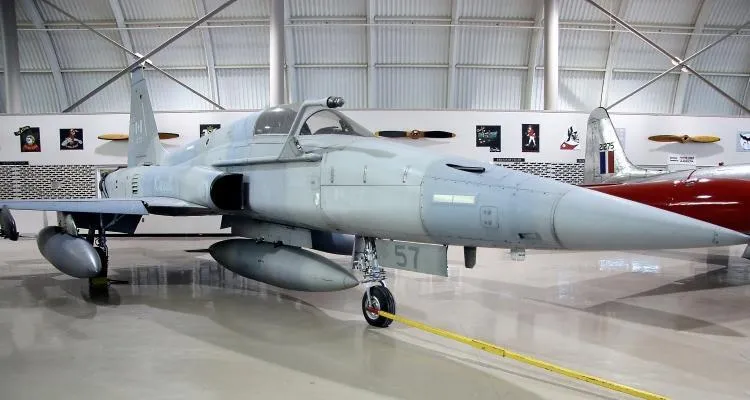
Canadian Warplane Heritage Museum
Northrop Aviation designed the F-5 Freedom Fighter in the mid 1950s to meet an anticipated need for a lightweight, well armed, supersonic fighter that was relatively inexpensive. Initially the USAF was not interested in such an aircraft, but did require a supersonic trainer. It encouraged continued development of a two seat version, which became the T-38 Talon trainer. In May 1958, the US Defense Department reconsidered its position and ordered three prototypes for its Military Assistance Program (MAP). The first prototype flew in July 1959 and exceeded Mach 1 during its first flight. After another three years of development, the F-5 was selected by the Defense Department for the MAP in 1962. In 1965 the RCAF decided to replace its home based North American Canadair Sabres with a new aircraft. The F-5 was chosen and Canadair was selected to manufacture it, with Orenda Ltd. of Toronto building its General Electric J85(GE)-15 turbojet engines. A total of 89 CF-5A fighters and 46 CF-5D trainers were purchased by the Canadian Armed Forces. Production of the CF-5A started in Montreal in 1967 and the first aircraft flew from Edwards AFB, California in May 1968. The first CAF unit to receive aircraft was AETE (Uplands), when both fighter and trainer versions were delivered for testing at the end of 1968. No. 434 "Bluenose" Squadron at CFB Cold Lake, Alberta was equipped with CF-5s soon after in 1969. No. 433 "Porcupine" Squadron, reactivated in September 1969 at CFB Bagotville, was the other squadron to receive CF-5s that year. Later on, both No. 1 FTS (Cold Lake) and No. 419 "Moose" Squadron flew CF-5s in both trainer and tactical fighter roles. The CF-5A continued in service as a tactical fighter until 1988, when the CF-18 Hornet replaced it. The CAF continued to use CF-5Ds as advanced trainers until 1995. A total of 2,350 F-5 Freedom Fighters were produced, between 1962 and 1975; 240 of them by Canadair in Montreal (135 for the CAF and 105 for the Royal Netherlands Air Force). The Museum's CF-5A was built by Canadair in Montreal in 1970. After it was retired from the Canadian Forces in 1989, it was moved to the RCAF Memorial Museum in Trenton, Ontario. Canadian Warplane Heritage Museum acquired the aircraft from the Department of National Defence in 1996.. Canadian Warplane Heritage Museum
Unit Desciption
419 (F) Sqn Moosa Aswayita ("Moose")
History of the Squadron during World War II (Aircraft: Wellington IC, III, Halifax II, Lancaster X)
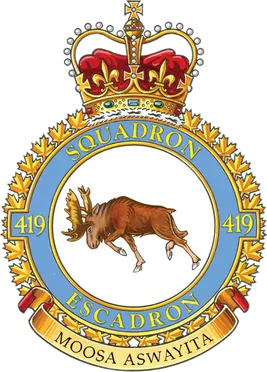
419 (Bomber) Squadron formed at RAF Mildenhall, Suffolk, UK ![]() in 1941 as part of No 3 Group of Bomber Command. It got its name from its first commanding officer, Wing Commander John "Moose" Fulton, DSO, DFC, AFC. The squadron operated Vickers Wellington, then Handley Page Halifax and finally Avro Lancaster bombers through the course of WWII, with the squadron code letters VR. It was the third RCAF bomber unit to be formed in England. It started operations in January 1942, converting almost immediately from Wellington Mk ICs to Wellington Mk IIIs and then moving north to Leeming, Yorkshire,
in 1941 as part of No 3 Group of Bomber Command. It got its name from its first commanding officer, Wing Commander John "Moose" Fulton, DSO, DFC, AFC. The squadron operated Vickers Wellington, then Handley Page Halifax and finally Avro Lancaster bombers through the course of WWII, with the squadron code letters VR. It was the third RCAF bomber unit to be formed in England. It started operations in January 1942, converting almost immediately from Wellington Mk ICs to Wellington Mk IIIs and then moving north to Leeming, Yorkshire, ![]() as part of 4 Group Bomber Command in August 1942. After short stays at Topcliffe
as part of 4 Group Bomber Command in August 1942. After short stays at Topcliffe ![]() and Croft
and Croft ![]() , it moved to Middleton St. George, County Durham
, it moved to Middleton St. George, County Durham ![]() in November 1942, from which it flew until the end of hostilities. Here in November 1942 it was re-equipped with Halifax Mk IIs, which it flew for the next 18 months on the night offensive against Germany. In January 1943 it joined the newly formed 6 (RCAF) Group of Bomber Command.
in November 1942, from which it flew until the end of hostilities. Here in November 1942 it was re-equipped with Halifax Mk IIs, which it flew for the next 18 months on the night offensive against Germany. In January 1943 it joined the newly formed 6 (RCAF) Group of Bomber Command.
In April 1944 the squadron began to convert to the Avro Lancaster Mk X, which was produced in Canada and flown across the Atlantic. The squadron remained continuously on the offensive until 25 April 1945, when it flew its last sortie. Squadron personnel flew a total of 4,325 operational sorties during the war from Mannheim to Nuremberg, Milan to Berlin and Munich to Hanover, inflicting heavy damage on the enemy. On completion of the war in Germany, the squadron was earmarked to become part of the proposed "Tiger Force" to continue the war against Japan. However, the Japanese surrender in August 1945 led to the disbandment of the squadron in at Yarmouth, Nova Scotia ![]() September 1945.
September 1945.
As a result of its wartime record, 419 Squadron became one of the most decorated units under the RCAF during the war. Over a span of roughly three-and-a-quarter years it logged 400 operational missions (342 bombing missions, 53 mining excursions, 3 leaflet raids and 1 "spoof") involving 4,325 sorties. A total of one hundred and twenty nine aircraft were lost on these operations. Members of the squadron accumulated 1 VC, 4 DSO's, 1 MC, 150 DFC's, 3 bars to DFC, 1 CGM, 35 DFM's: the VC was awarded posthumously to Flight Sergeant Andrew Mynarski for his attempts to help a fellow crew member escape from their burning aircraft. Battle Honours were: English Channel and North Sea 1942-44, Baltic 1942-44, Fortress Europe 1942-44, France and Germany 1944-45, Biscay Ports 1942-44, Ruhr 1942-45, Berlin 1943-44, German Ports 1942-45, Normandy 1944, Rhine, Biscay 1942; 1944. Wikipedia, Kostenuk and Griffin
![]() Squadron History (Bomber Command Museum)
Squadron History (Bomber Command Museum)
Maps for Movements of 419 Squadron 1941-45
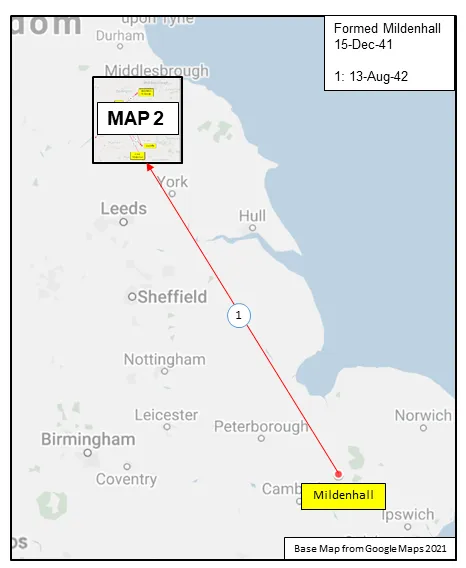
MAP 1: 419 Squadron Movements Dec 1941-Aug-42 (right-click on image to display enlarged new tab)
|
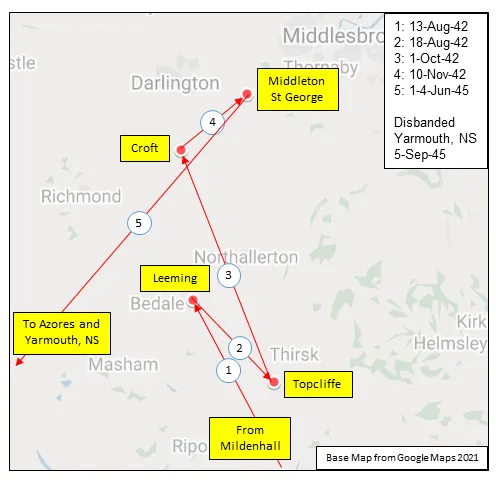
MAP 2: 419 Squadron Movements Aug 1942-Jun 1945
|
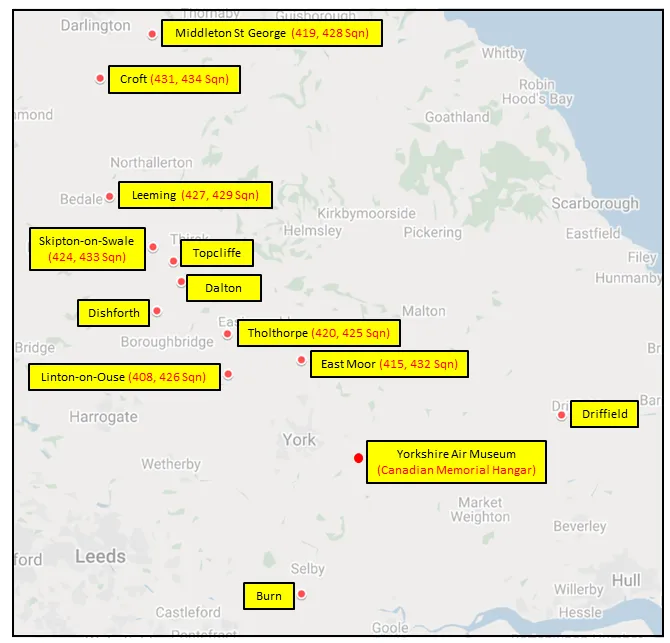
MAP 3: 6 Group Bomber Bases 1943-1945
|
419 Squadron History Summary 1941-45
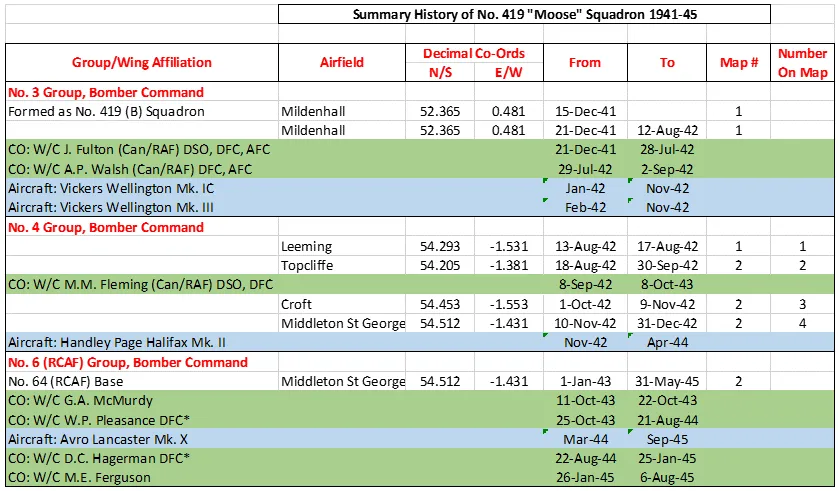
419 Squadron History Summary 1941-45 Page 2

History of the Squadron Post-WWII (Aircraft: Canuck, Silver Star, Freedom Fighter, Hornet)
The squadron was reactivated on 15 March 1954 at North Bay, Ontario ![]() , as an all-weather fighter squadron flying the CF-100 Canuck. It moved to the NATO Air Division base at Baden-Soellingen, Germany
, as an all-weather fighter squadron flying the CF-100 Canuck. It moved to the NATO Air Division base at Baden-Soellingen, Germany ![]() shortly after being formed. The squadron remained there until its disbandment in December 1962.
shortly after being formed. The squadron remained there until its disbandment in December 1962.
The squadron was again re-formed in December 1970, when it relocated to Cold Lake, Alberta ![]() as No. 1 Canadian Forces Flight Training School. It initially flew the T-33 Silver Star but then transitioned to the Canadair CF-5 Freedom Fighter. The squadron was on full active duty in November 1975 but disbanded again 20 years later when the CF-5’s were retired in June 1995.
as No. 1 Canadian Forces Flight Training School. It initially flew the T-33 Silver Star but then transitioned to the Canadair CF-5 Freedom Fighter. The squadron was on full active duty in November 1975 but disbanded again 20 years later when the CF-5’s were retired in June 1995.
The squadron was again reactivated as 419 Tactical Fighter (Training) Squadron on 23 July 2000. The squadron has since conducted Phase IV of the NATO Flying Training Canada (NFTC) program for the air forces of Canada, Austria, Denmark, Italy, Hungary, Saudi Arabia, Singapore, the United Arab Emirates and the United Kingdom. This program trains basic jet pilots to become fighter pilots and prepares them for training on CF-188 class aircraft through instruction in Air-to-Air and Air-to-Ground combat tactics over a six month period.
